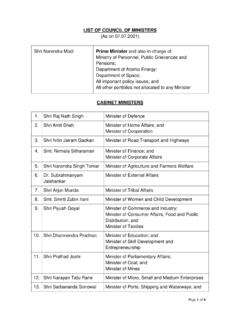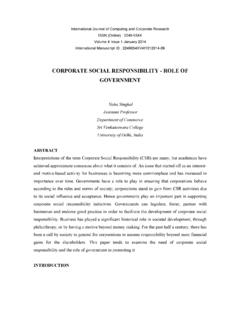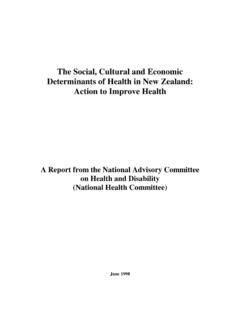Transcription of National Development Planning and Implementation
1 Economic and social Council Annual Ministerial Review 2014 National Voluntary Presentation National Development Planning and Implementation Human Development , Sustainable Development and National Well-being State of Qatar New York July 2014 3 April 2014 2 Executive Summary Governments everywhere are increasingly focused on sustainable Development and the post-2015 Development agenda. At the United Nations Rio+20 Conference in June 2012, the State of Qatar reaffirmed its commitment to sustainable Development and to ensuring the promotion of an economically, socially and environmentally sustainable future and National well-being.
2 The three pillars of sustainable Development permeate Qatar s National Planning . Qatar National Vision (QNV) 2030 and Qatar National Development Strategy 2011-2016 (NDS) set out a programme of initiatives aimed at maintaining a balance between the countries Development needs and ensuring sustainable prosperity for future generations. 2013 provided an opportunity to review progress in NDS Implementation including achievements made so far, challenges and directions for the period 2014 2016. The NDS Mid-term Review (MTR) was undertaken with active engagement of stakeholders.
3 Qatar is committed to advancing the well-being of its population and has made tremendous progress in improving human Development moving from 57th in 1997, to 36th out of 187 countries in 2012 in UNDP's Human Development Index. Maintaining progress necessitates continued social sector investments, particularly in young people. Overall success in achieving National Development goals cannot be measured only through the use of traditional indicators. Based on subjective measures of well-being overall 84% of persons living in households in Qatar expressed that they were either very or somewhat satisfied with their lives.
4 Rapid infrastructure Development and population growth, as well as the changes to social behaviour brought about by the country s financial wealth, are creating strains and stresses. Between 2008 and 2013, Qatar s population grew from million to over 2 million. The rapid increase in the expatriate population and the labour force create a wide range of challenges for National and sector Planning strategies. Qatar has a young population and the number of youth aged 15 to 24 is growing rapidly from 14% of the population in 2000 to of the population in 2012.
5 Investing time, efforts and resources in Qatar s youth will provide young men and women with opportunities and choices throughout their lifetime, and will help build the human capital required for making QNV 2030 a reality. The Ministry of Youth and Sports established in 2013 will increase support and investments in youth programmes and include the voices of youth in policy and decision-making processes. The NDS MTR identified several key lessons learnt including the need for ministries and agencies to establish Executive Plans with the NDS at its core, the need to establish mechanisms for greater sector-wide, cross-sector and inter-agency collaboration on NDS projects.
6 It also gave recognition to an urgent need for additional project management and technical capacity and expertise within the ministries and agencies for project Implementation , monitoring and evaluation, as well as for policy Development . 3 1. Introduction Qatar s National Development Planning Framework The focus of world leaders on sustainable Development as the only viable way forward for our future and that of our children has been intensified through the high-level intergovernmental process to articulate a set of sustainable Development goals with related targets and monitorable indicators for the post-2015 Development agenda.
7 The State of Qatar reaffirmed its commitment to sustainable Development at the 2012 United Nations Conference on Sustainable Development , Rio+20. Simultaneously balancing social Development , economic growth and environmental protection, taking account of their inter-linkages, is the aim Qatar s National Development thrusts. Qatar National Vision 2030 (QNV 2030), launched in November 2008 by the then Heir Apparent, His Highness The Emir Sheikh Tamim Bin Hamad Al-Thani, which defines the country s long-term Development outcomes, incorporated sustainability as its underlying principle.
8 The Vision, built on four inter-related Development pillars of human, social , economic and environmental Development , mainstreams sustainable Development . Cognizant of the challenges facing the country, QNV 2030 envisages that National Development will be carried out with responsibility and respect, balancing and integrating the economic, social and environmental dimensions. It recognises the critical importance of forging regional and international alliances consistent with the global partnership for Development . QNV 2030 foresees Qatar becoming a vibrant, prosperous and advanced country with high standards of living and sustainable prosperity for all of its people.
9 Qatar s National Development Strategy 2011-2016 (NDS), launched in March 2011, is a 6-year programme of action that aligns the growth of National prosperity to the realities of environmental constraints, with sustainability threaded throughout. The NDS aims to advance National transformation towards the goals and objectives of QNV 2030. It is the country s first National Development strategy and also includes initiatives to modernise public sector institutions. It contains priority National Development programmes, projects and initiatives for 14 sectors, with related outcomes and targets to be achieved by 2016.
10 The NDS outcomes and targets are themselves a subset of those contained in 14 comprehensive sectors strategy reports. The end of 2013, the midpoint of Qatar s 6-year Planning cycle, provided an opportunity to take stock of Implementation progress of the NDS, to learn lessons that will inform future Planning and execution and to identify critical gaps. It also enabled account to be taken of emerging new Development priorities that have arisen in the period 2010-2013, and that were not foreseen when the strategy was prepared in 2010 and to make the necessary adjustments at the sector and National levels.
















